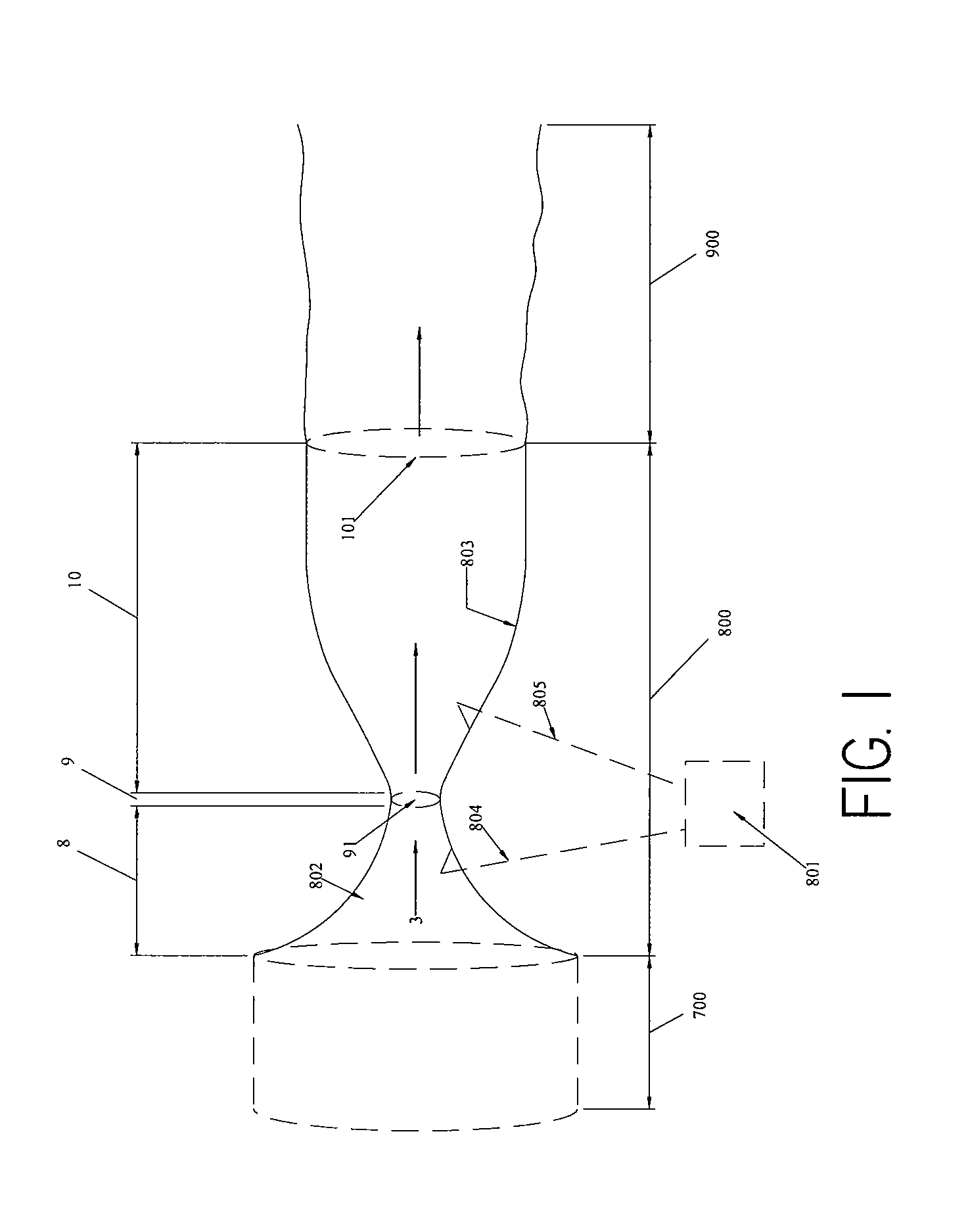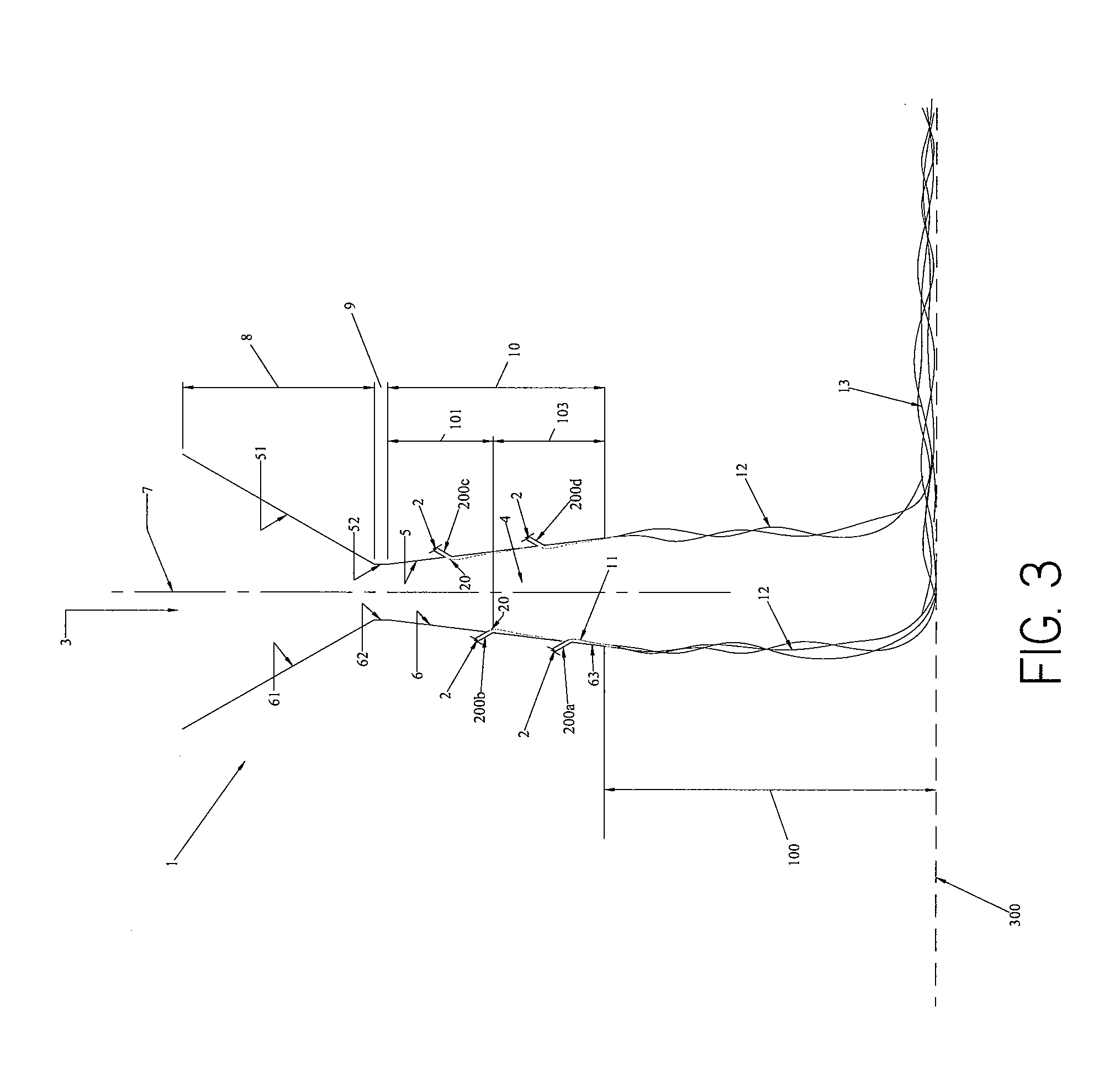[0015]As another
advantage of the present invention, increased sub-micron
fiber output is obtained with lower gas demand. Lowered gas demand makes it possible to reduce
energy consumption and / or use smaller
scale unit operations to still provide commercially significant sub-micron fiber output levels. In one embodiment, the gas
stream and polymer fluid
stream are introduced into the second section at a gas
stream / polymer fluid stream
mass flow
rate ratio less than about 40:1, particularly less than about 30:1; more particularly less than about 15:1. The gas stream to polymer fluid stream
mass flow ratio is calculated as
kilogram per hour per meter of gas stream through the gas passage to
kilogram per hour per meter of polymer fluid stream through all the polymer openings in the second section of the gas passage.
[0016]In more particular embodiments, each polymer passage opening may be a slit with a hydraulic
diameter defined as four times cross-sectional area of the polymer passage opening divided by inner perimeter of the polymer passage opening, said hydraulic
diameter of each polymer passage opening
ranging from about 0.001 inch to about 0.100 inch. The polymer film generally has a polymer film thickness not exceeding the hydraulic diameter of the polymer passage opening. The polymer fluid may expand upon exiting the polymer passage opening, for example, due to
die swell phenomenon without being limited by theory. However, the polymer fluid film thickness almost instantaneously becomes lesser than or equal to the hydraulic diameter of the polymer passage opening.
[0017]In characterizing the geometry of the wall-defined gas passage of the nozzle of the present invention, a first bisecting surface, defined as an angular bisector of the angle between the first and second walls in the first section, geometrically divides the first section into two halves with about equal volumes, and a second bisecting surface, defined as an angular bisector of the angle between the first and second walls in the second section, geometrically divides the second section into two halves with about equal volumes. The bisecting surface may be planar or curvilinear, depending on the embodiment of the present invention, as will be more apparent from the detailed descriptions herein. In a general embodiment, the bisection angle of the first and the second walls with respect to the first bisecting surface ranges from about 15 to about 40 degrees in the first section, and the bisection angle of the first and the second walls with respect to the second bisecting surface ranges from about 2 to about 20 degrees in the second section of the gas passage.
[0018]The opposing walls of nozzle where polymer is introduced into the gas passage may be operated such that they are thermally similar or different. In one embodiment, the first and second walls of the gas passage are heated to approximately the same temperature to provide symmetric thermal states with respect to the first and the second bisecting surfaces. In an alternative embodiment, one of the opposing walls may be a hot wall while the other wall is a cold wall, wherein temperature of the hot wall is at least higher than the cold wall, such as at least 50° C. higher, and only the hot wall has at least one polymer fluid passage opening. In this configuration, the microfibers may be produced in a
hot melt / “cold” gas (e.g., unheated air)
fibrillation environment that reduces
process complexity and costs. In this embodiment, the hot wall in the second section diverges away from the first bisecting surface at an angle that ranges from about 1 degree to 20 degrees, and the cold wall in the second section converges towards the first bisecting surface at an angle that ranges from about 0.1 degree to about 15 degrees. The ratio between the diverging angle of the hot wall relative to the first bisecting surface and the converging angle of the cold wall relative to the first bisecting surface may range from about 1:1 to about 500:1. The angle between centerline of each polymer passage and the wall containing the corresponding polymer passage opening may range from about 10 degrees to about 100 degrees. The polymer film extruding from each polymer passage opening may flow with the gas flow along a polymer fiberization surface, which has an orientation angle with respect to the first bisecting surface
ranging from about 90 degrees measured in
clockwise direction to about 45 degrees measured in counterclockwise direction. The length of the polymer fiberization surface corresponding to each polymer passage opening may be less than about one thousand times the hydraulic diameter of the corresponding polymer passage opening.
[0019]In another embodiment, the first and second walls of the gas passage are smoothly curved such that the curvature of the opposing walls in the first section smoothly transitions without any sharp edges into the curvature of the opposing walls in the second section in the region of smallest cross-section area of the gas passage. The opposing walls in the second section of the gas passage may be curved such that the hot wall has a convex shape that curves away from the second bisecting surface and the cold wall has a concave shape that curves towards the second bisecting surface as viewed from within the second section in the gas passage. The ratio of the
radius of curvature of the hot wall to the
radius of curvature of the cold wall in the second section of the gas passage ranges from about 1:10,000 to about 100:1. The gas stream is introduced into the gas passage at a
mass flow rate
ranging from about 150
kilogram per hour per meter to about 3500 kilogram per hour per meter.
[0020]The nozzle used in the processes described herein for making nonwoven webs comprising sub-micron fibers represents another embodiment of the present invention. The inventive nozzle device is not limited to any particular type of polymer material or fibrillating gas and allows for the polymer to be independently selected for a specific application from amongst a wide variety of polymeric materials. Particularly the fibrillating gas is a gaseous material such as air,
nitrogen, steam, etc. The gas may be used as a
single type thereof or as combinations of different gases. Additionally suitable gases may include reactive gases or gases with
reactive components, or combinations thereof. In embodiments, the gas generally may be
inert to the nozzle wall materials. For purposes herein, the terms “nozzle
system” and “nozzle” are used interchangeably.
 Login to View More
Login to View More 


